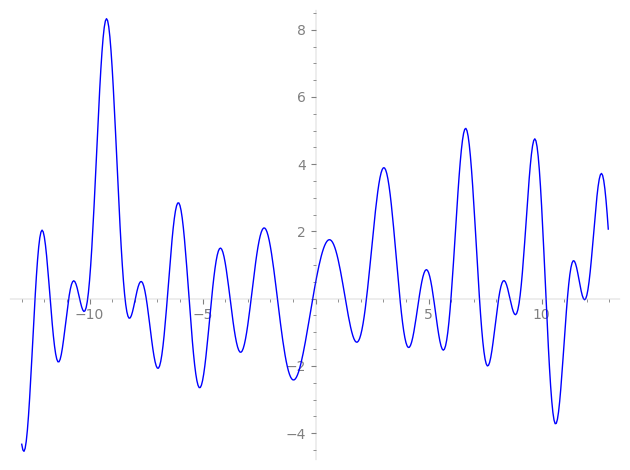| L(s) = 1 | + (−3.31 + 5.73i)5-s + (8.46 − 4.88i)7-s + (−10.0 + 5.80i)11-s + (8.93 − 15.4i)13-s − 2.37·17-s + 14.0i·19-s + (−35.9 − 20.7i)23-s + (−9.43 − 16.3i)25-s + (−5.68 − 9.85i)29-s + (18.0 + 10.4i)31-s + 64.7i·35-s − 35.7·37-s + (2.62 − 4.55i)41-s + (−54.4 + 31.4i)43-s + (4.28 − 2.47i)47-s + ⋯ |
| L(s) = 1 | + (−0.662 + 1.14i)5-s + (1.20 − 0.698i)7-s + (−0.914 + 0.528i)11-s + (0.687 − 1.19i)13-s − 0.139·17-s + 0.738i·19-s + (−1.56 − 0.902i)23-s + (−0.377 − 0.653i)25-s + (−0.196 − 0.339i)29-s + (0.581 + 0.335i)31-s + 1.85i·35-s − 0.965·37-s + (0.0641 − 0.111i)41-s + (−1.26 + 0.731i)43-s + (0.0911 − 0.0526i)47-s + ⋯ |
\[\begin{aligned}\Lambda(s)=\mathstrut & 1728 ^{s/2} \, \Gamma_{\C}(s) \, L(s)\cr =\mathstrut & (-0.640 + 0.768i)\, \overline{\Lambda}(3-s) \end{aligned}\]
\[\begin{aligned}\Lambda(s)=\mathstrut & 1728 ^{s/2} \, \Gamma_{\C}(s+1) \, L(s)\cr =\mathstrut & (-0.640 + 0.768i)\, \overline{\Lambda}(1-s) \end{aligned}\]
Particular Values
| \(L(\frac{3}{2})\) |
\(\approx\) |
\(0.4754691255\) |
| \(L(\frac12)\) |
\(\approx\) |
\(0.4754691255\) |
| \(L(2)\) |
|
not available |
| \(L(1)\) |
|
not available |
\(L(s) = \displaystyle \prod_{p} F_p(p^{-s})^{-1} \)
| $p$ | $F_p(T)$ |
|---|
| bad | 2 | \( 1 \) |
| 3 | \( 1 \) |
| good | 5 | \( 1 + (3.31 - 5.73i)T + (-12.5 - 21.6i)T^{2} \) |
| 7 | \( 1 + (-8.46 + 4.88i)T + (24.5 - 42.4i)T^{2} \) |
| 11 | \( 1 + (10.0 - 5.80i)T + (60.5 - 104. i)T^{2} \) |
| 13 | \( 1 + (-8.93 + 15.4i)T + (-84.5 - 146. i)T^{2} \) |
| 17 | \( 1 + 2.37T + 289T^{2} \) |
| 19 | \( 1 - 14.0iT - 361T^{2} \) |
| 23 | \( 1 + (35.9 + 20.7i)T + (264.5 + 458. i)T^{2} \) |
| 29 | \( 1 + (5.68 + 9.85i)T + (-420.5 + 728. i)T^{2} \) |
| 31 | \( 1 + (-18.0 - 10.4i)T + (480.5 + 832. i)T^{2} \) |
| 37 | \( 1 + 35.7T + 1.36e3T^{2} \) |
| 41 | \( 1 + (-2.62 + 4.55i)T + (-840.5 - 1.45e3i)T^{2} \) |
| 43 | \( 1 + (54.4 - 31.4i)T + (924.5 - 1.60e3i)T^{2} \) |
| 47 | \( 1 + (-4.28 + 2.47i)T + (1.10e3 - 1.91e3i)T^{2} \) |
| 53 | \( 1 - 75.7T + 2.80e3T^{2} \) |
| 59 | \( 1 + (50.3 + 29.0i)T + (1.74e3 + 3.01e3i)T^{2} \) |
| 61 | \( 1 + (5.93 + 10.2i)T + (-1.86e3 + 3.22e3i)T^{2} \) |
| 67 | \( 1 + (20.6 + 11.9i)T + (2.24e3 + 3.88e3i)T^{2} \) |
| 71 | \( 1 + 46.4iT - 5.04e3T^{2} \) |
| 73 | \( 1 + 104.T + 5.32e3T^{2} \) |
| 79 | \( 1 + (-18.0 + 10.4i)T + (3.12e3 - 5.40e3i)T^{2} \) |
| 83 | \( 1 + (-24.4 + 14.0i)T + (3.44e3 - 5.96e3i)T^{2} \) |
| 89 | \( 1 + 73.0T + 7.92e3T^{2} \) |
| 97 | \( 1 + (-71.1 - 123. i)T + (-4.70e3 + 8.14e3i)T^{2} \) |
| show more | |
| show less | |
\(L(s) = \displaystyle\prod_p \ \prod_{j=1}^{2} (1 - \alpha_{j,p}\, p^{-s})^{-1}\)
Imaginary part of the first few zeros on the critical line
−8.429341398981286287605068086627, −7.972901008139280802169331133952, −7.48976735040020896105267205900, −6.56107042639958621477219260743, −5.59547715788955783590456176350, −4.60050544541675309390788937908, −3.78046891151807239311969656792, −2.84973839994441759867209721228, −1.68712197968272805708447168116, −0.12543064962068943529062557705,
1.31633506480747887009863811431, 2.25201943289160056426061161677, 3.73322301472102444974700881671, 4.57358887105600142732809748047, 5.22351335196026265145454688768, 5.98942910552429475990470797941, 7.25241280540553028337209460362, 8.099225513725071430754563361872, 8.601946265054088390844414621748, 9.032447431417327550728392703513

